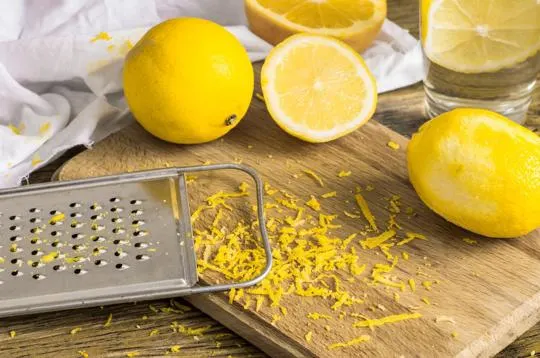Summary of key points
The main difference between lemon zest and lemon juice is that lemon zest contains the essential oils and aromatic compounds from the outer layer of the lemon peel, while lemon juice is extracted from the fruit’s pulp.
This affects both flavor and usage in cooking. Lemon zest has a strong citrus aroma and can add a burst of flavor to dishes, while lemon juice provides a more tart and acidic taste.
Zest is often used as a garnish or added for extra flavor, while lemon juice is commonly used in dressings, marinades, and sauces. Both are versatile ingredients that can add a bright and refreshing element to any dish.
Lemon zest and lemon juice are like siblings. One’s zesty, the other’s juicy. They bring pizzazz to any dish. We’ve all been there, squeezing a lemon till our hands cramp, right? Then there’s the zest. Ever grated your knuckles instead of the lemon? Ouch.
Lemon zest is the colorful outer skin, packed with oils and aroma. It’s the secret weapon in our kitchen arsenal. Lemon juice? That’s the tart, liquid gold we love and loathe to squeeze.
Together, they’re a dynamic duo. Separated, they each tell a unique story in cooking. We’ve all had that “oops” moment mixing them up in recipes. Lesson learned.
What is Lemon Zest?

Lemon zest is the outermost layer of a lemon’s peel. Get it using a zester or grater.
It adds flavor and fragrant to dishes and drinks. It enhances taste and gives texture.
Its yellow color brings brightness to desserts, sauces and salads.
When added to baked goods, it imparts a fresh and tangy aroma.
It has essential oils with health benefits.
These oils are believed to have antioxidant properties.
They also contain vitamin C for boosting the immune system.
To extract lemon zest, use unwaxed lemons or wash them thoroughly before grating.
Gently scrape the surface without going too deep.
The fine strands can be used or stored in an airtight container.
What is Lemon Juice?

Lemon juice is the liquid extracted from lemons. It’s tangy and acidic, adding flavor to dishes and drinks.
This ingredient is popular for cooking, baking, and cocktail-making because of its taste and acidity.
Some key points about lemon juice:
- Its acidity varies based on ripeness and extraction method. On average, its pH level is between 2 and 3, making it quite acidic. This acidity adds flavor and preserves food naturally.
- Lemons are high in vitamin C, which is great for the immune system and has antioxidant properties. Including lemon juice in your diet is a great way to get more vitamin C.
- Lemon juice can replace vinegar in recipes. It adds a zesty flavor to dressings, marinades, and sauces. It also pairs well with herbs, spices, and honey.
Lemon juice is flavorful and healthy.
Adding it to drinks or recipes can add a fresh burst of flavor and complexity.
Differences Between Lemon Zest and Lemon Juice

Lemon zest and lemon juice may look similar, but they have distinct differences.
Source and Preparation
When looking to add a zesty flavor to dishes, lemon zest and juice are two great ingredients.
Despite coming from the same source, there are differences in how they are prepared and used.
Lemon zest is the outermost layer of the peel.
This layer has aromatic oils that give lemons their unique scent.
To get lemon zest, you must grate or peel off this layer carefully, using only the colored part.
This zest adds a citrusy flavor to food, perfect for marinades, sauces, and baked goods.
For lemon juice, it comes from the lemon itself. To get it, you can use a juicer or squeeze it.
It has a tart and tangy taste and can be used in dressings, cocktails, and as a preservative.
When it comes to intensity, lemon zest has a more concentrated and fragrant flavor than lemon juice.
It can give recipes an aromatic boost without taking away other flavors.
Lemon juice is more acidic and can balance out rich flavors in savory dishes.
Texture and Appearance
Texture and appearance are essential to telling lemon zest apart from lemon juice.
Zest is finely grated, giving it a powdery texture.
Its bright yellow hue adds a burst of flavor to dishes.
Lemon juice, on the other hand, is more liquid and translucent. It has a pale yellow color.
Both have their own unique uses in cooking and baking, even though they come from the same fruit.
Flavor Profile and Aroma
Lemon zest and juice are different in flavor and aroma.
Zest has citrus, floral, and tangy flavors, plus a strong scent.
Juice has a zesty, sour taste.
Both ingredients add extra flavor to cooking.
Zest adds yellow color, while juice adds acidity.
They make dishes such as salads, desserts, marinades, and cocktails brighter and tastier.
Culinary Uses
Lemon zest and juice appear alike, but they don’t have the same culinary uses.
Both are tangy and bright, yet offer their own flavor and texture.
Zest is the outermost peel of the fruit, with essential oils that bring intense citrus taste.
It’s widely used for baking, enhancing salads, pasta, and seafood.
Juice, on the other hand, is from the fruit’s flesh and adds a sharp acidic flavor.
It’s great for marinades, sauces, and drinks.
Lemon juice is stronger compared to zest, which has a milder citrus flavor that complements other ingredients.
Knowing the difference helps us explore new flavors.
Lemon juice adds a punch, while zest enhances delicately.
Both bring unique elements to the table for a mouthwatering experience.
Similarities Between Lemon Zest and Lemon Juice

Lemon zest and juice may look similar, but they have distinct differences.
Lemon zest is the outermost part of the lemon peel.
It has flavorful oils that give intense flavor to dishes.
Juice is the liquid inside the lemon.
It has a high acidity that can cut through richness in recipes.
These two ingredients are used differently.
Zest is added at the beginning or middle to infuse its flavor.
Juice is added at the end to keep its freshness and vibrant taste.
Both bring flavor to food and drinks.
The zest’s essence creates multi-dimensional flavors while preserving visual appeal.
Juice brings brightness and balance to recipes.
Whether it’s savory or sweet dishes, zest and juice both have an important role.
Enhancing Dishes with Lemon Zest and Lemon Juice
Adding zing to dishes with lemon zest and juice.
Lemon zest and juice are incredible ingredients that can take the taste of dishes to the next level.
Want a kick? Or a tangy flavor? These citrus elements have you covered.
Let’s explore how they can make your cooking stand out.
- Lemon Zest: The outer skin of lemons hold the secret to its zesty flavor. Grating this layer releases aromatic oils, giving your dish a burst of citrusy essence. Lemon zest adds a fresh and tangy note, perfect for adding flavor to savory recipes like roasted vegetables, fish, or chicken.
- Lemon Juice: Directly extracted lemon juice offers a sharp acidity that can be either refreshing or acidic, depending on its application. Its sourness can balance flavors and compliment sweet or savory dishes. From dressings and marinades to cocktails and desserts, lemon juice is a versatile ingredient that boosts the overall taste profile.
- Combining Lemon Zest and Juice: When used together, lemon zest and juice provide a great mix of aroma and acidity. Zest gives a lively fragrance while the juice adds its characteristic tartness. This dynamic duo is especially effective in baked goods like cakes, cookies, or pies.
- Freshness Matters: Using fresh lemons is essential. Ripe lemons ensure optimal flavors and aromas that will bring life to your dishes. Also, remember to wash them to remove any wax residue or pesticides.
Incorporating lemon zest and juice into your cooking opens up a world of possibilities.
Experiment with these citrus powerhouses and let their tangy magic take your dishes to a whole new level.
A little zest or a squeeze of juice can make all the difference.
Conclusion
In conclusion, lemon zest and juice used in cooking and baking offer distinct flavors and properties.
While both derived from the same fruit, lemon juice is made from the expressed oil of citrus rinds whereas lemon zest is a flecked form consisting of the skin with no pulp or juice.
Lemon juice can easily lend an overpowering sour taste to dishes, while varieties like Meyer lemons tend to have a more mellow flavor.
On the other hand, using lemon zest instead imparts a subtle sweetness as well as vibrant color and scent that some say are reminiscent of springtime.
Each ingredient offers its own unique power when it comes to flavoring dishes. I encourage you to experiment.
Start by substituting citrus like lemons for other ingredients you may not love – take intriguing chances, find recipes that intrigue you and play around with them; even if something doesn’t quite work out, it’s all part of understanding how flavors interact with each other through trial and error.
With patience and practice, any cook can become the master of their own kitchen domain.

Leave a comment